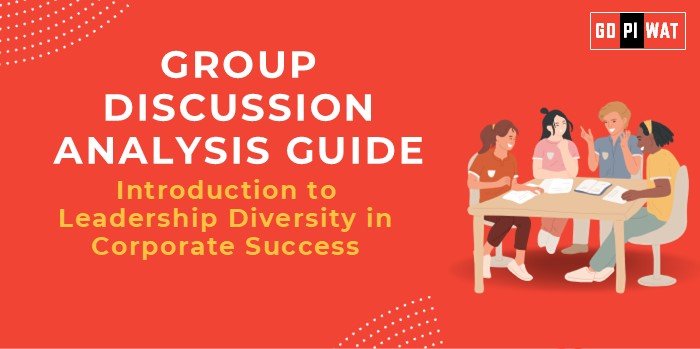📋 Group Discussion Analysis Guide
🌍 Introduction to Leadership Diversity in Corporate Success
Opening Context: “As companies expand globally, leadership diversity has become a cornerstone of corporate success, ensuring varied perspectives, innovation, and inclusivity in decision-making.”
Topic Background: Leadership diversity encompasses gender, ethnicity, age, experiences, and backgrounds within top corporate roles. Studies by institutions like McKinsey & Co. have shown a direct correlation between leadership diversity and business performance.
📊 Quick Facts and Key Statistics
- 💡 Diverse Teams Perform 35% Better: Companies in the top quartile for diversity outperform competitors by 35% (McKinsey, 2023).
- 💼 Women CEOs: Only 10.4% of Fortune 500 CEOs are women (2024).
- 🌍 Ethnic Representation: Ethnically diverse executive teams achieve 36% higher profitability (Harvard Business Review).
- 👩💻 Millennial Leadership: Millennials will make up 75% of the workforce by 2025, demanding inclusive leadership.
🎯 Stakeholders and Their Roles
- Corporations: Commit to inclusive hiring and diversity initiatives for long-term success.
- Governments: Policies promoting gender and social equity in leadership.
- Investors: Increasingly consider diversity metrics as investment criteria.
- Employees: Advocate for inclusive leadership that reflects workplace culture.
🏆 Achievements and Challenges
🌟 Achievements
- 💡 Innovation and Problem-Solving: Diverse teams bring multiple viewpoints, leading to better decision-making.
- 🌐 Market Insight: Diverse leadership understands multicultural markets, enhancing global reach.
- 📈 Improved Financial Performance: Companies with above-average diversity saw 19% higher revenue (BCG, 2023).
⚠️ Challenges
- 🎭 Tokenism: Appointing diverse leaders symbolically without providing genuine decision-making power.
- 🧠 Bias and Resistance: Unconscious biases hinder diverse representation at leadership levels.
- 🔍 Implementation Gaps: Companies often lack structured frameworks for fostering diversity.
🌍 Global Comparisons
- 🇳🇴 Norway: Mandatory quotas ensured 40% female board representation since 2008.
- 🇺🇸 USA: Companies like Microsoft and IBM promote racial and gender diversity in leadership.
🛠️ Structured Arguments for Discussion
- Supporting Stance: “Diverse leadership improves financial outcomes, drives innovation, and aligns businesses with changing demographics.”
- Opposing Stance: “Focusing solely on diversity can compromise meritocracy and business efficiency if not managed effectively.”
- Balanced Perspective: “While diversity is crucial, companies must ensure equal opportunities and implement strategies to maximize its benefits.”
🚀 Effective Discussion Approaches
- Opening Approaches:
- 📊 “A McKinsey report reveals diverse leadership enhances financial performance by 35%, proving inclusivity is a corporate success driver.”
- 📈 “Despite being 50% of the workforce, women hold only 10% of Fortune 500 CEO roles—highlighting leadership gaps.”
- Counter-Argument Handling: “While concerns exist about forced diversity impacting merit, structured frameworks ensure qualified and capable leaders thrive.”
🔑 Strategic Analysis of Strengths and Weaknesses
- Strengths: Proven business and innovation benefits, Diverse leadership attracts talent and global customers.
- Weaknesses: Slow implementation and systemic biases.
- Opportunities: Inclusion initiatives in emerging markets, Technology to eliminate bias in hiring and promotions.
- Threats: Resistance to change in traditional corporate cultures, Ineffective tokenism damaging diversity credibility.
🎓 Connecting with B-School Applications
- Real-World Applications: Leadership diversity is central to management studies—HR policies, cross-cultural management, and ethics.
- Sample Interview Questions:
- “How does leadership diversity impact organizational culture and success?”
- “Discuss an example of a company leveraging diversity for global expansion.”
- Insights for Students: Emphasize diversity in leadership as a research area for operations, finance, and cultural transformation projects.


